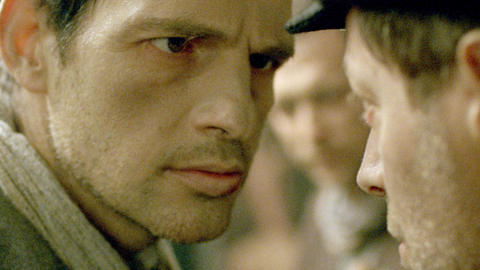
Son of Saul: Movement, Meaning and Morality
Posted on Thu 14 April 2016
The blistering Oscar®-winning Holocaust drama Son of Saul opens at the end of the month. Our Cinema Curator Mark Cosgrove saw it in Cannes last year, and here writes a bit more about the film, and the morality of the choices inherent in making films that portray human atrocities.
Son of Saul, a blistering Holocaust drama that picked up both the Oscar® and the Golden Globe for Best Foreign Language film, is the debut from Hungarian director László Nemes.
Our Cinema Curator Mark Cosgrove saw it in Cannes last year, and in advance of its release on Fri 29 April, has written a bit more about the film, and the morality of the creative choices inherent in making films that portray human atrocities. Have a read below - or alternatively listen to it in Podcast form - and let us know your thoughts on the subject via Twitter @wshed (Watershed) or @msc45 (Mark).
In 1959, in the French film magazine Cahiers du Cinema, critic and filmmaker Luc Moullet famously said that "morality is a matter of tracking shots" which his colleague Jean Luc Godard equally famously inverted to "tracking shots are a matter of morality."
Whichever way you want to inflect it – and I think there is a subtle difference – what the critics at Cahiers du Cinema articulated and argued over was the connection and impact of not only the way the camera moved but the whole aesthetic language of filmmaking to the ethical, social and political. This thing - film - was more than mere entertainment.
Their observations applied primarily to fiction – although arguments could be made about documentary.
That connection between camera movement, meaning and morality was made most pointedly and concisely by another Cahiers critic Jacques Rivette writing on Gillo Pontecorvo's 1960 concentration-camp set film Kapo. There is a scene where one of the characters throws her self onto an electrified fence the camera then moves in to frame her dead body with her arms up over wires. It only lasts for a few seconds before dissolving to black and into the next scene.
Of this short sequence Rivette said:
"The man who decides, at that moment, to have a dolly in to tilt up at the body, taking care to precisely note the hand raised in the angle of its final framing – this man deserves nothing but the most profound contempt."
The Holocaust is a lightening rod for discussions about how you portray and represent real atrocities in fiction. Indeed, there is an argument that you simply cannot and should not because by the simple fact of attempting to represent it you diminish what actually happened.
The Cahiers critics were not taking this particular position but rather asking the question of what is the appropriate visual language to represent a subject matter? Put another way, the filmmaker has a responsibility to the subject matter when deciding how to frame the world they are representing to us. This takes on added importance and moral weight when that event is of the order of something like the Holocaust.
Hungarian filmmaker László Nemes is an example of a filmmaker who is absolutely aware of the powerful connection between and implications of film language and morality. The 38 year old’s first feature film Son of Saul is a powerful depiction of life inside Auschwitz focussing on a Sonderkommando - camp inmates who were forced to lead those others to their death in the gas chambers and to dispose of the bodies afterwards. This particular Sonderkommando becomes convinced one of the bodies is his son and tries to get some kind proper burial.
When I first saw Son of SauI I compared its effect to that of reading Primo Levi – the feeling of being close in on the horror. Clearly, written or film language cannot transport you to that reality but in the hands of a great communicator they can intimate or allude to that horror. Levi is obviously one and who actually lived the experience but think also of Goya’s Disasters of War or Picasso's Guernica.
Son of Saul's visual language is very specific: for the bulk of the film the camera follows the main character in tight close up, the screen ratio is academy – the square picture frame of silent film – which, combined with the tight close ups accentuates intensity and makes the rest of the world of the film claustrophobic with everything else happening on the edges of perception. You do not get the establishing shot or wide locating shot that allows you to see the "true" space of the setting. Something that Spielberg’s Schindler's List was criticised for – as though there is some comprehending position or overview of the events. Instead Son of Saul is fragmentary and deeply disquieting.
In a recent edition of Film Comment magazine critic Jonathan Romney argued for Son of Saul's depiction and the director’s aesthetic strategy. However not everyone agrees. Depictions of the Holocaust and other atrocities are always going to be contentious. In the same edition critic Stefan Grissemann, argued that Son of Saul "is an exploitation film not despite but because of its technical skill." In effect it is making us feel suspense about something that should not in any way be depicted as suspenseful.
One might also ask why Nemes felt it important to tell this particular story at this time. I'll leave the last words to him.
"I'm not a religious person but I have a very deep connection to Judaism and I see how much destruction the European Jews have suffered. And I made this film to talk about this lost civilization and this lost world, and also because I’m angry that this happened, and Europe never really understood that."
Son of Saul opens on Fri 29 April, and will screen for at least one week.
- Mark Cosgrove, Watershed Cinema Curator @msc45 / mark@watershed.co.uk